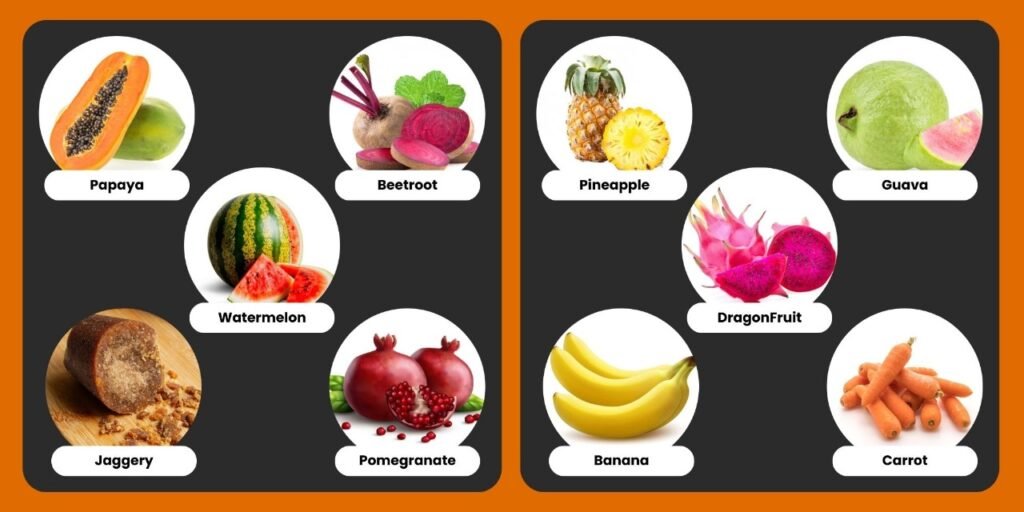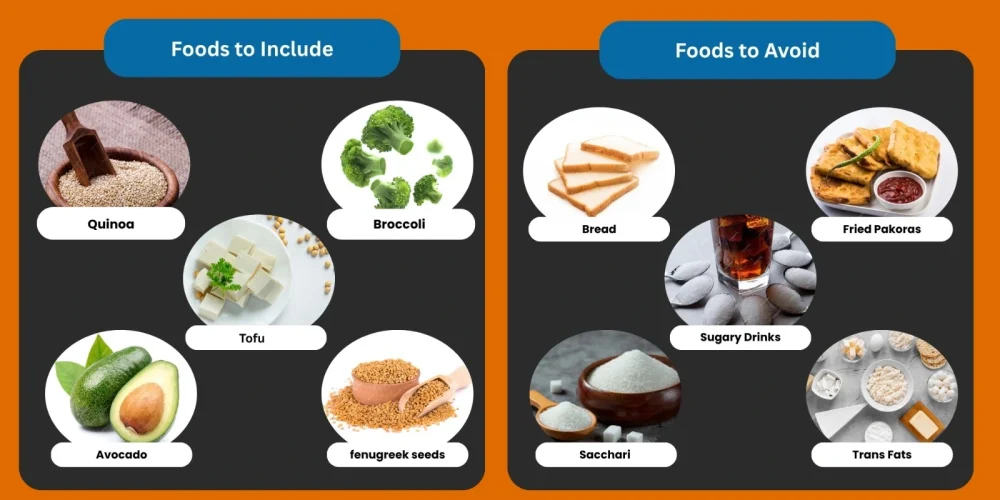
Diabetes is a chronic condition characterized by elevated blood glucose levels due to the body’s inability to produce or effectively use insulin. Managing diabetes requires a multifaceted approach, with diet playing a pivotal role. A well-structured diabetes food chart serves as a roadmap, guiding individuals to make informed food choices that stabilize blood sugar levels and promote overall health.
Absolutely. Dietary modifications can significantly impact blood sugar control. Incorporating low-glycemic foods, rich in fibre and essential nutrients, can aid in managing diabetes. For instance, questions like Is beetroot good for diabetes? or Is papaya good for diabetes? often arise. Both these fruits, when consumed in moderation, can be beneficial due to their fibre content and antioxidant properties.
Carbohydrates have the most immediate effect on blood sugar levels. Opting for complex carbs like whole grains, legumes, and vegetables can provide sustained energy without causing spikes. Proteins and healthy fats, such as those from lean meats, nuts, and seeds, play a crucial role in satiety and blood sugar stabilisation.
The glycemic index (GI) measures how quickly a food raises blood sugar levels, while the glycemic load (GL) considers both the GI and the carbohydrate content in a typical serving. For example, is watermelon good for diabetes? While watermelon has a high GI, its GL is low due to its high water content, making it acceptable in moderation.
Fibre slows the absorption of sugar, aiding in blood sugar control. Incorporating fibre-rich foods like vegetables, legumes, and whole grains is essential. Portion control ensures that calorie intake aligns with energy expenditure, preventing weight gain, a risk factor for type 2 diabetes. Regular meal timings help in maintaining consistent blood sugar levels.
Staying hydrated aids in the elimination of excess glucose through urine. Water is the best choice, but herbal teas and infused waters can also be beneficial. Avoid sugary drinks that can cause rapid blood sugar spikes.
Creating a personalized diabetes food chart can simplify meal planning. Here’s a sample plan:
• Morning Drink: Warm water with lemon or fenugreek seeds
• Breakfast: Oatmeal topped with chia seeds and a few slices of papaya (Yes, is papaya good for diabetes?—its low GI makes it suitable)
• A handful of almonds
• A small bowl of beetroot salad (Addressing is beetroot good for diabetes?—rich in fibre and antioxidants)
• Brown rice or quinoa
• Grilled chicken or tofu
• Mixed vegetable stir-fry
• A small serving of pomegranate seeds (Answering is pomegranate good for diabetes? beneficial in moderation)
• Herbal tea
• A slice of guava (Responding to Is guava good for diabetes?—high in fibre and vitamin C)
• Lentil soup
• Whole grain bread
• Steamed vegetables
• A few pieces of dragon fruit (Considering is dragon fruit good for diabetes?—low in calories and sugar)
• A cup of warm milk with turmeric
• A small piece of carrot (Touching on is carrot and beetroot good for diabetes?—both are low in calories and high in fibre)
| Meal Time | Food Options |
|---|---|
| Morning Drink | Warm water with lemon or fenugreek seeds |
| Breakfast | Oatmeal with chia seeds, slices of papaya |
| Mid-Morning | Almonds, beetroot salad |
| Lunch | Grilled chicken/tofu, vegetable stir-fry, brown rice, pomegranate seeds |
| Evening Snack | Herbal tea, a slice of guava |
| Dinner | Lentil soup, steamed vegetables, whole grain bread, pieces of dragon fruit |
| Bedtime Snack | Warm milk with turmeric, small piece of carrot |
☆ Is Beetroot Good for Diabetes?
Yes, beetroot is rich in dietary fibre and antioxidants, which can help manage blood sugar levels. Consuming it in moderation, especially in raw or boiled form, is advisable.
☆ Is Papaya Good for Diabetes?
Indeed, papaya has a low glycemic index and is rich in vitamins A and C. Its fiber content aids in digestion and blood sugar control. Check out our detailed guide: Is Papaya Good for Diabetes?
☆ Is Watermelon Good for Diabetes?
While watermelon has a high GI, its high water content results in a low GL, making it acceptable in small portions.
☆ Is Pomegranate Good for Diabetes?
Pomegranate is packed with antioxidants and has anti-inflammatory properties. Consuming a small quantity can be beneficial.
☆ Is Pineapple Good for Diabetes?
Pineapple has a moderate GI. When eaten in controlled portions, it can be included in a diabetic diet.
☆ Is Guava Good for Diabetes?
Guava is rich in dietary fiber and vitamin C, which can help in blood sugar regulation. It’s a good snack option.
☆ Is Dragon Fruit Good for Diabetes?
Dragon fruit is low in calories and sugar, making it a suitable choice for diabetics.
☆ Is Banana Good for Diabetes?
Bananas have a higher GI compared to other fruits. However, consuming half a banana or pairing it with protein can mitigate blood sugar spikes.
☆ Is Jaggery Good for Diabetes?
Jaggery is an unrefined sugar and can cause blood sugar spikes. It’s best avoided or consumed in minimal amounts.
☆ Is Carrot and Beetroot Good for Diabetes?
Both carrots and beetroots are high in fiber and nutrients. When consumed in moderation, they can be part of a diabetic-friendly diet.
| Category | Foods to Include | Foods to Avoid |
|---|---|---|
| Whole Grains | Brown rice, quinoa, barley, steel-cut oats, whole wheat roti | White rice, maida (refined flour), white bread |
| Vegetables | Spinach, broccoli, kale, bottle gourd, okra, zucchini, bell peppers | Potato (in excess), sweet corn (limit), yam |
| Fruits | Papaya, guava, pomegranate, dragon fruit, watermelon (in moderation), pineapple (controlled portions) | Mango, grapes, custard apple, banana (large portions) |
| Lean Proteins | Tofu, paneer, lentils, chickpeas, boiled eggs, grilled chicken, fish (like salmon) | Deep-fried meats, processed meats (sausages, salami) |
| Healthy Fats | Avocado, olive oil, flaxseed, walnuts, almonds, chia seeds, ghee (in moderation) | Margarine, trans fats, vanaspati, hydrogenated oils |
| Functional Foods & Spices | Cinnamon, fenugreek seeds, turmeric, curry leaves, garlic | Excessive salt, packaged seasoning blends with sugar |
| Snacks | Roasted chana, sprouts, fresh veggie sticks with hummus | Fried snacks (pakoras, chips), bakery items (puffs, pastries) |
| Beverages | Water, herbal teas, lemon water, buttermilk (unsweetened) | Sugary drinks, soft drinks, packaged juices, energy drinks |
| Sugar Alternatives | Stevia, monk fruit extract (natural alternatives) | Jaggery, artificial sweeteners like aspartame, saccharin (in excess) |
| Lifestyle Tip (Bonus) | Daily walks, fiber-rich meals, timely meals, yoga for diabetes | Skipping meals, late-night binging |

Food directly affects blood sugar levels. The right choices help maintain glucose balance and prevent complications.
Yes, a balanced diet with fibre-rich, low-GI foods can help manage blood sugar naturally. Consistency and portion control are key.
Yes, fruits like papaya, guava, and pomegranate are safe in moderation. Always consider the glycemic index and load before choosing fruits.
Yoga improves insulin sensitivity, reduces stress, and supports weight control. Regular practice, like the 7 yoga poses for diabetes, complements dietary efforts.
A diabetes food chart is a structured meal plan guiding food choices for stable blood sugar. It helps simplify daily meal planning and promotes healthier habits.
Managing diabetes effectively requires a holistic approach encompassing diet, exercise, and lifestyle modifications. By adhering to a structured diabetes food chart, making informed food choices, and integrating practices like yoga for diabetes, individuals can achieve better glycemic control. For personalised guidance and comprehensive care, consulting a Diabetologist in Thane is recommended.
Service Road, Ghodbunder Rd, next to AP Shah Institute of Technology, Kasarvadavali, Thane West, Maharashtra 400615
Pioneering Excellence in Neurology and Neurosurgery with Cutting-Edge Technology and Compassionate Care. Solaris Hospital is your one-stop destination for comprehensive with wide range of multi-specialty services.
Service Road, Ghodbunder Rd,
next to AP Shah Institute of
Technology, Kasarvadavali,
Thane (West),
Maharashtra. 400615
Phone:+91 22 4004 4001 / 4004 4003 / 8655696500
E-mail:contact@solarishospitals.com
